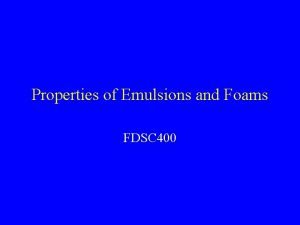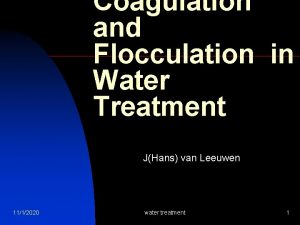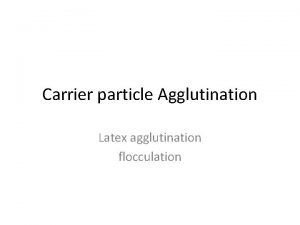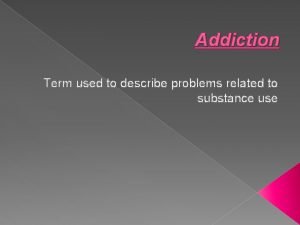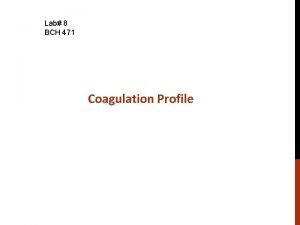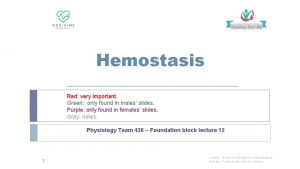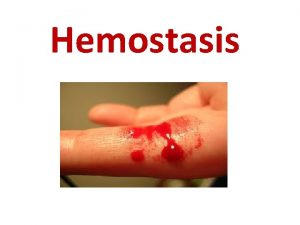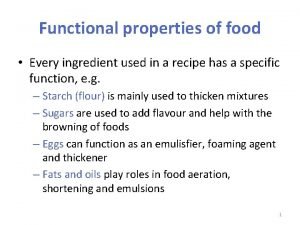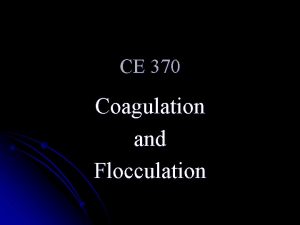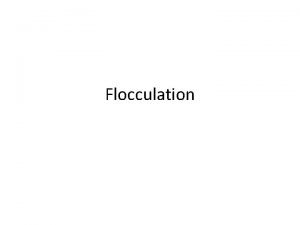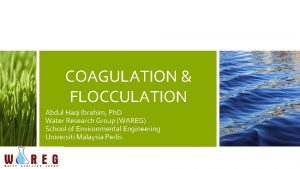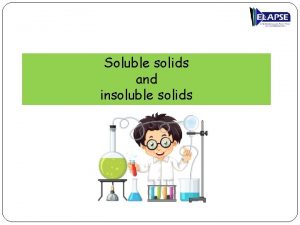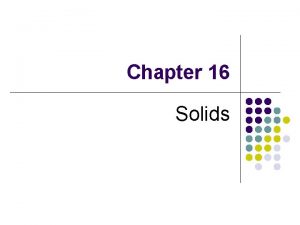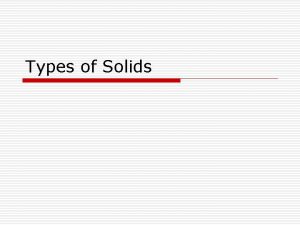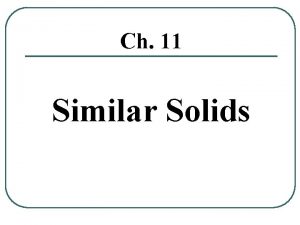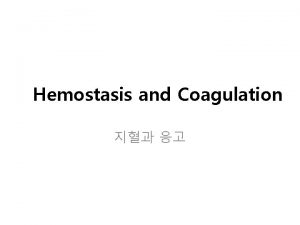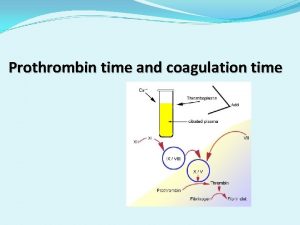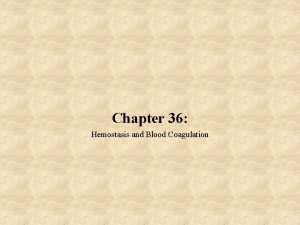Coagulation and Flocculation 5 1 Suspended solids in














- Slides: 14

Coagulation and Flocculation 5. 1 Suspended solids in water include sand, soil, organic materials, bacteria, viruses and other. Typical size variations of particulates found in surface water are list in Table (5. 1). A suspension of particles that will not settled is known as a stable suspension. The particles that make up(5. 1): these suspension are known Table Particle size found in water treatment as colloids. Material Particle diameter (Micrometer) Viruses Bacteria Small colloids Large colloids Soil Sand Floc particle 0. 005 – 0. 01 0. 3 – 3 0. 001 – 0. 1 – 100 500 100 – 2000

The colloidal suspension may contain: - organic materials - metal oxides - insoluble toxic compounds - stable emulsions - material producing turbidity Colloids are commonly classified as: · hydrophilic : Hydrophilic colloids are typically formed by large organic molecules that become hydrated (solvated) when they are in the presence of water (e. g. , proteins) · hydrophobic : Hydrophobic colloids are made of small colloidal particles having little or no affinity for water (the solvent) (e. g. , clays, metal oxides).

5. 2 Characteristics of Colloids The principal phenomena that control the behavior of the colloids are zeta potential (electrostatic force), Vander Walls forces and Brownian motion. The amount of coagulant to be added to the water will depend on the zeta potential, a measurement of the magnitude of electrical charge surrounding the colloidal particles. The zeta potential is the amount of repulsive force or electric charge, which keeps the particles in the water. If the zeta potential is large, then more coagulants will be needed. Vander Wall's forces refer to the tendency of particles in nature to attract each other weakly if they have no charge. Once the particles in water are not repelling each other, vander Wall’ s forces make the particles drift toward each other and join together into a group. Colloids have a sufficiently small mass that collusions with molecular size particles in water will cause constant movement of the colloids. The phenomenon of constant random movement of colloids is known as Brownian motion. The combination of positive and negative charge, results in a neutral, or lack of charge. As a result, the particles no longer repel each other. When enough particles have joined together, they become floc and will settle out of the water.

5. 7 Flocculation is the process of gentle and continuous stirring of coagulated water for the purpose of forming flocs through the aggregation of the minute particles present in the water. It is thus the conditioning of water to form flocs that can be readily removed by settling, dissolved air flotation or filtration, fig (5. 8). The efficiency of the flocculation process is largely determined by the number of collisions between the minute coagulated particles per unit of time.

5. 3 Theory of coagulation Coagulation is a water treatment process that causes very small suspended particles to attract to one another and form larger particles. Then the coagulation process transfers the stable colloids particles to destabilized colloids particles by adding coagulants, as shown in Fig. (5. 1).

Fig (5. 1) Schematic representation of destabilization of colloids

5. 4 Effects of Coagulation Treatment on Wastewater Primary Effect: · Agglomeration and eventual removal of colloids (primarily responsible for wastewater turbidity and color) Secondary Effects: · Precipitation of some chemical species in solution such as phosphates, that can be present in the wastewater. · Agglomeration of larger particles in the floc.

5. 5 Chemicals Used for Coagulation Coagulant reactions are carried out by the addition of coagulant, usually a metal salt to water. Commonly used coagulants are aluminum sulfate (alum), ferric sulfate Fe 2(SO 4)3 and ferric chloride Fe. Cl 3. 5. 5. 1 Use of Aluminum Sulfate (Alum) Aluminum Sulfate is obtainable either as liquid alum or in the form of lumps. Also, it is the most widely used in drinking water. It is easily handled and not expensive. When aluminum sulfate is added to water that contains calcium bicarbonate, the following reaction takes place: 1 mg alum will produce 0. 23 mg of insoluble 2 Al(OH)3 precipitates and will consume 0. 45 mg of alkalinity as Ca. CO 3.

5. 5. 2 Use of Ferric Sulfate ferric sulfate is applied with relative ease, and it produces a good flocs over a rather wide range of p. H values. It has a particular advantage where manganese is present in sufficient amounts to require removal. When ferric sulfate is used, the following reaction occurs: 1 mg of ferric sulfate will produce 0. 54 mg of insoluble Fe(OH)3 precipitates and will consume 0. 75 mg of alkalinity as Ca. CO 3

5. 5. 3 Use of Ferric Chloride 1 mg of ferric chloride will produce 0. 66 mg of insoluble Fe(OH)3 precipitates and will consume 0. 92 mg of alkalinity as Ca. CO 3

5. 5. 4 Use of Polyelectrolytes The term polyelectrolytes refers to all water-soluble organic polymers used for clarification, whether they function as coagulants or flocculants. Water-soluble polymers may be classified as follows: anionic-ionize in water solution to form negatively charged sites along the polymer chain - cationic-ionize in water solution to form positively charged sites along the polymer chain - nonionic-ionize in water solution to form very slight negatively charged sites along the polymer chain There are many coagulant aid as lime, soda ash, activated silica. Other chemical used in coagulation as sulfuric Acid, H 2 SO 4, is used infrequently to acidify waters prior to treatment. Sodium Hydroxide, Na. OH, which is also known as caustic soda, is an effective alkali. Also, when used to produce alkalinity, it does not increase the hardness of the water. Sodium silicates, consisting of sodium oxide, Na 2 O, and silica, Si. O 2, in various proportions, are use in conjunction with aluminum sulfate to produce large floc particles. In the so-called high-rate upward-flow clarifiers, such large particles are especially desirable after being compacted and agglomerated by slow agitation.

5. 6 Coagulant dosage Although there is some relation between turbidity of the raw water and the coagulant dosage, the exact quantity can be determined only by trial. Even thus determined amount will vary with other factors such as time of mixing and water temperature. The use of minimum quantity of coagulant to be effective in producing good flocculation in any given water, will usually require a fairly long stirring varying from 15 to 30 minutes in summer and 30 to 60 minutes in the colder months. Water of low turbidity with very finely divided suspended matter is more difficult to coagulate than water with high turbidity and coarse particles, necessitating a larger quantity of coagulant.

Jar Test The coagulant dose in the water treatment should be judiciously controlled based on the results of jar test as the turbidity level is continuously changing. The jar test apparatus is shown below, fig (5. 2) Fig. (5. 2) Jar test apparatus

Procedure for jar test Analyze the collected natural surface water for p. H, turbidity, and alkalinity. Record both the water temperature at time of test and ambient air temperature. Place water samples in one liter beakers on the six-jar laboratory stirrer and check stirrer operation. At the start of a one minute rapid mix at 100 rpm, add coagulant solutions at 10, 20, 30, 40, and 50 mg/L respectively to each of 5 beakers and use one beaker as a control Fig. 2. 2 Jar Test apparatus (i. e. , no coagulant added). Flocculate at slow mix at 15 rpm for 20 minutes. Record the elapsed time before a visible floc is formed. If large flocs are formed, it may be desirable to reduce the paddle speed. Note the size and appearance of the floc formed. After flocculation, remove the paddles and allow for a settling period of 30 minutes or wait until most of the floc is removed from suspension. Measure the alkalinity, turbidity, and p. H of each jar at the end of 30 minutes. Select the optimum dosage on the basis of supernatant clarity and settleability of floc with secondary considerations to cost and sludge production.
 Mixed liquor suspended solids
Mixed liquor suspended solids Flocculation geography definition
Flocculation geography definition Hydraulic baffled wall flocculator
Hydraulic baffled wall flocculator Flocculation test syphilis
Flocculation test syphilis Flocculation delirium
Flocculation delirium Coagulation diathermy
Coagulation diathermy Disseminated intravascular coagulation pathophysiology
Disseminated intravascular coagulation pathophysiology Clotting time capillary tube method
Clotting time capillary tube method Coagulation made easy
Coagulation made easy Coagulation profile test
Coagulation profile test Dégénérescence hydropique
Dégénérescence hydropique Primary hemostasis
Primary hemostasis 13 blood coagulation factors names
13 blood coagulation factors names Dextrinisation food examples
Dextrinisation food examples Maillard reaction eggs
Maillard reaction eggs

